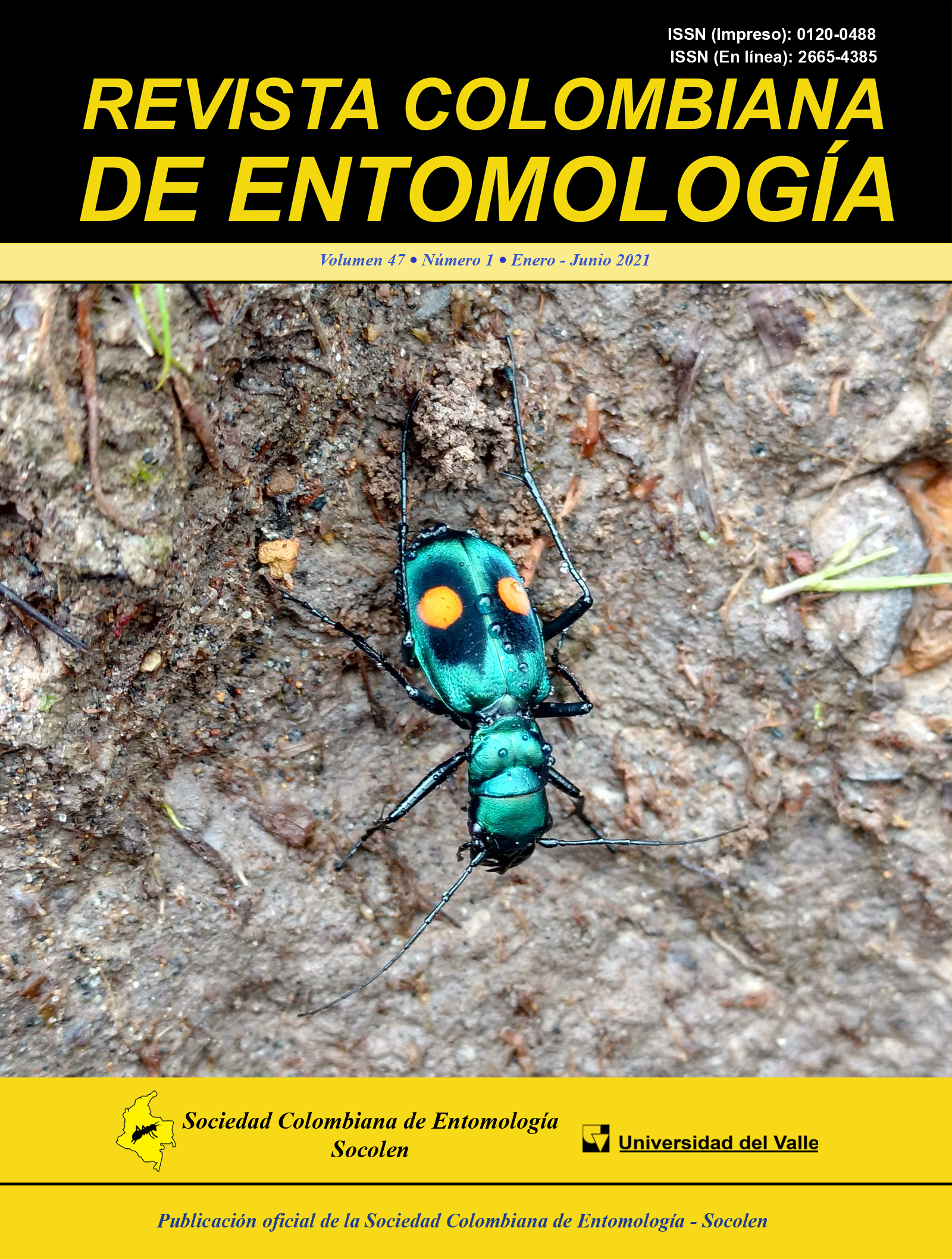Uso de modelos lineales generalizados en el conteo de Leptopharsa gibbicarina (Hemiptera: Tingidae) en palma de aceite
Contenido principal del artículo
El análisis de los datos provenientes del recuento de eventos debe tener en cuenta las herramientas apropiadas para tratar este tipo de variables. Un enfoque válido para hacer frente a esta tarea consiste en el uso del Modelo Lineal Generalizado (MLG). Esto permite trabajar con funciones de densidad como Poisson o binomial negativa. Este trabajo presenta los resultados del análisis de los datos de un experimento realizado en el campo experimental de investigación de Cenipalma ubicada en el municipio de Barrancabermeja (Colombia). El experimento se estableció para evaluar, a nivel de campo, el hongo entomopatógeno Purpureocillium lilacinum como una estrategia para controlar la población de la chinche de encaje, Leptopharsa gibbicarina. El experimento se realizó en dos parcelas, en una de ellas se implementó el control de L. gibbicarina con P. lilacinum como sugería el programa de investigación de Entomología de Cenipalma y en la otra parcela no se tuvo ninguna estrategia de control. Los datos se analizaron mediante el uso de MLG y dos funciones de densidad diferentes (Poisson y binomial negativa). Los resultados mostraron diferencias estadísticamente significativas entre los tratamientos. El estimador de máxima verosimilitud asociado al tratamiento P. lilacinum indicó que la aplicación del hongo entomopatógeno reduce la población de L. gibbicarina con una tasa de incidencia de 0,28 veces más que el testigo.
- sobredispersión
- función enlace
- hongo entomopatógeno
- equidispersión
- chinche de encaje
- Leptopharsa gibbicarina
AGRESTI, A. 2002. Categorical Data Analysis. 2nd Edition. Jhon Wiley & Sons, Inc., Hoboken. New Jersey, EE. UU. 710 p.
ARANGO LONDOÑO, D.; ORTEGA LENIS, D.; OLAYA OCHOA, J. 2009. Modelación del número de homicidios vía regresión de Poisson. Heurística 16: 81-90. https://bibliotecadigital.univalle.
edu.co/bitstream/handle/10893/6105/Heuristica16-A07.pdf
BARRIOS, T. C. E.; BUSTILLO P., A. E.; OCAMPO R., K. L.; REINA C., M. A.; ALVARADO M., H. L. 2016. Eficacia de hongos entomopatógenos en el control de Leptopharsa gibbicarina
(Hemiptera: Tingidae) en palma de aceite. Revista Colombiana de Entomología 42 (1): 22-27. https://doi.org/10.25100/socolen.v42i1.6665
CARRILLO-RAYAS, M. T.; BLANCO-LABRA, A. 2009. Potencial y algunos de los mecanismos de acción de los hongos entomopatógenos para el control de insectos plaga. Acta Universitaria
(2): 40-49. https://doi.org/10.15174/au.2009.102
DOBSON, A. J.; BARNETT, A. G. 2018. An introduction to generalized linear models. Chapman and Hall / CRC Press. 4th Edition. Boca Raton, EE. UU. 392 p.
DRAPER, N. R.; SMITH, H. 1981. Applied regression analysis. 2nd Edition. John Wiley & Sons. New York, EE. UU. 709 p.
HINDE, J.; DEMÉTRIO, C. G. B. 1998. Overdispersion: Models and estimation. Computational Statistics & Data Analysis 27 (2): 151-170. https://doi.org/10.1016/S0167-9473(98)00007-3
KUEHL, R. O. 2000. Design of experiments: Statistical principles of research design and analysis. 2nd Edition. Duxbury/Thomson Learning. Belmont, California, EE. UU. 666 p.
LEHMANN, E. L. 2006. Nonparametrics: Statistical methods based on ranks. Springer Science & Business Media. New York, EE. UU. 463 p.
LINDSEY, J. K. 1995. Modelling frequency and count data. Oxford Science Publications/Clarendon Press. Oxford, England. 291 p.
McCULLAGH, P.; NELDER, J. A. 1989. Generalized linear models. 2nd Edition. Chapman and Hall. Londres, England. 526 p. http:// www.utstat.toronto.edu/~brunner/oldclass/2201s11/readings/glmbook.pdf
MELO MARTÍNEZ, O. O.; LÓPEZ PÉREZ, L. A.; MELO MARTÍNEZ, S. E. 2007. Diseño de experimentos: métodos y aplicaciones. Universidad Nacional de Colombia. Bogotá, Colombia.
p. https://www.uneditorial.com/bw-diseno-de-experimentos- metodos-y-aplicaciones-fisica.html MORALES, M. A.; LÓPEZ, L. A. 2009. Estudio de homogeneidad de la dispersión en diseño a una vía de clasificación para datos de proporciones y conteos. Revista Colombiana de Estadística 32 (1): 59-78. https://revistas.unal.edu.co/index.php/estad/article/
view/29754
NAVARRO, A.; UTZET, F.; PUIG, P.; CAMINAL, J.; MARTÍN, M. 2001. La distribución binomial negativa frente a la de Poisson en el análisis de fenómenos recurrentes. Gaceta Sanitaria 15 (5): 447-452. https://doi.org/10.1016/S0213-9111(01)71599-3
NELDER, J. A.; WEDDERBURN, R. W. M. 1972. Generalized linear models. Journal of the Royal Statistical Society, Series A 135 (3): 370-384. https://doi.org/10.2307/2344614
PUCHETA DÍAZ, M.; FLORES MACÍAS, A.; RODRÍGUEZ NAVARRO, S.; DE LA TORRE, M. 2006. Mecanismo de acción de los hongos entomopatógenos. Interciencia 31 (12): 856-860. Disponible en: https://www.researchgate.net/publication/ 46406133_Mecanismo_de_accion_de_los_hongos_entomopatogenos [Fecha revisión: 15 diciembre 2020]
SÄRNDAL, C-E.; SWENSSON, B.; WRETMAN, J. 2003. Model assisted survey sampling. Springer Science & Business Media. Örebro, Sweden. 694 p.
SAS INSTITUTE INC. 2008. SAS/STAT® 9.2. User’s guide, Introduction to Statistical Modeling with SAS/STAT Software. SAS Institute. Cary, North Carolina, EE. UU. 60 p. https://support.
sas.com/documentation/cdl/en/statugstatmodel/61751/PDF/default/
statugstatmodel.pdf
SILVA, A. S.; MOTA, T. A.; PIÑEYRO, N. G.; FERNANDES, M. G.; PEREIRA, F. F. 2016. Distribución espacial de Vatiga spp. (Hemiptera: Tingidae) en el cultivo de yuca. Acta Biológica
Colombiana 21 (1): 195-200. https://doi.org/10.15446/abc. v21n1.46762 TORRES BLANCO, A. M. 2011. Estudio en bloques completos vía regresión Poisson en presencia de sobredispersión. Tesis Magister en Ciencias Estadística. Universidad Nacional de Colombia, Bogotá, Colombia. 68 p. https://repositorio.unal.edu.co/bitstream/handle/unal/75303/anamariatorresb.2011.pdf?sequence= 1&isAllowed=yZAR, J. H. 1996. Biostatistical analysis. 3th Edition. Prentice Hall.
New Jersey, EE. UU. 662 p.
Descargas
Aceptado 2020-11-06
Publicado 2021-02-03

Esta obra está bajo una licencia internacional Creative Commons Atribución-NoComercial-CompartirIgual 4.0.
Los autores conservan los derechos patrimoniales sobre su trabajo y son responsables de las ideas emitidas en ellos. Una vez un manuscrito sea aprobado para publicar se solicita a los autores una licencia de publicación por el término de la protección legal, para todos los territorios que permite el uso, difusión y divulgación de los mismos.





